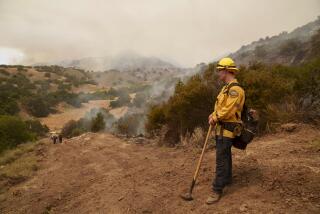Tinder-Dry Brush Sparks Fears of Major Wildfires
- Share via
Any hopes that California would somehow defy the signs and escape a monster wildfire season faded when searing heat and desiccating winds swept the state last week, feeding at least 320 grass and forest fires.
The hot, dry weather that greeted summer--and which finally began to break late in the week--has dried millions of acres of drought-ridden chaparral and brush into nearly ideal kindling for a major blaze, state and federal forestry officials said.
“A few days of high temperatures and wind can push the fire danger very high,” U.S. Forest Service spokesman Matt Mathes said.
Los Angeles fire officials also warned that the threat is very high in the brushy areas that run through and around the city. Deputy Fire Chief Donald Anthony said the last time the danger was this high in June was in 1961, when disastrous wildfires swept through Bel-Air.
“We’re at least three months ahead of where we would normally be” at this time of year, Anthony said.
Most of last week’s fires ignited in crispy dry grasslands and pine forests where crews were able to quickly reach and contain the flames, despite the unfavorable weather. About 5,000 acres were burned, though without serious injuries or extensive property damage.
So far this year more than 2,200 wild-land fires have consumed 15,900 acres in California, state Department of Forestry spokeswoman Karen Terrill said. On Wednesday alone, 87 new fires were reported on lands protected by the department, which covers 40 million acres of private forest and rangelands. “Wednesday was almost double what we would have expected,” Terrill said.
In a typical year, fire crews are brought onto the state and federal payroll gradually. But last week, when the fire season erupted rapidly and almost without warning, the firefighting system was forced to scramble into readiness.
Even as the rash of fires began, the part-time air force of tankers, water-scooping helicopters and spotter planes kept by the Forest Service, state Department of Forestry and federal Bureau of Land Management was still being brought to full strength and dispatched to bases throughout the state.
By midweek the system was largely in place, officials said. Fire patrols of wild-land areas had been scheduled more frequently and a full complement of fire crews sent to camps. Most recreation areas remained open without unusual limits on visitors, though five regional parks in the San Francisco Bay Area closed briefly because of the fire threat.
The fire season might have erupted with catastrophic speed two weeks ago. In one day, electronic sensors picked up more than 1,000 lightning strikes during a storm that swept south out of Oregon down the crest of the Sierra Nevada range. But the state’s luck held and the lightning was accompanied by rains that drenched the forests and prevented an outbreak of fires.
In 1987, a flurry of lightning strikes that were not accompanied by rain set off devastating fires in much of Northern California. The brush and weather conditions were similar much of last summer but California was spared a major incident--fortunate, fire officials say, because much of the state’s firefighting force was committed to the destructive Yellowstone National Park blaze.
Last week the culprit was an air mass of high pressure over the Pacific Northwest. It spun the warm, dry Santa Ana-like winds to life and held off moisture from the Pacific, raising the fire danger to warning levels at both ends of the state.
Drought Conditions
Forests and brushlands were already vulnerable after two years of drought and less-than-normal rain and snowfall last winter.
The largest fire last week scorched about 2,300 acres of grazing land near Travis Air Force Base in Solano County and forced a brief closure of California 12. About 1,200 acres burned near Joshua Tree National Monument in Southern California.
Another fire, in the Tahoe National Forest, erupted out of the embers left from a controlled burn set by the U.S. Forest Service two months ago. “It’s sort of embarrassing,” Forest Service spokeswoman Ann Westling said. “We had patrols on it for many weeks and thought it was out.”
The fire was intentionally set in the spring, when the forest floor was damp, to recycle the cuttings and debris--called slash--left by loggers. She said a smoldering ember was probably kicked up by the dry winds this week.
California 20 was closed for several hours near Nevada City Wednesday because of the fire, which was controlled after consuming 30 acres.
Prescribed Burns
Two intentional fires were also set this week in Yosemite and Sequoia-Kings Canyon National Parks, but officials said they were at higher elevations where the fire danger was much lower.
The Yosemite “prescribed burn”--the first in three years--was lit Monday at 6,700 feet near the Mariposa Grove of giant Sequoia trees. The temperature was 75 degrees and the humidity 30% at the time, and the area was spared the Santa Ana-like conditions in much of the rest of the state.
Plans call for 173 acres to burn, some beneath the giant Sequoias. “The reproduction of Sequoia trees is dependent on fire,” park resource manager Steve Underwood said.
More to Read
Sign up for Essential California
The most important California stories and recommendations in your inbox every morning.
You may occasionally receive promotional content from the Los Angeles Times.













